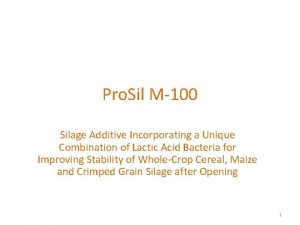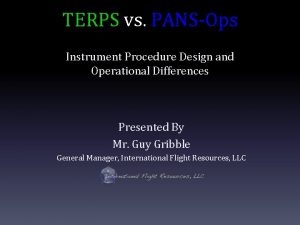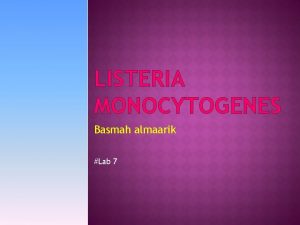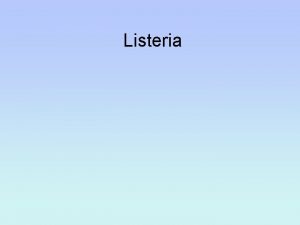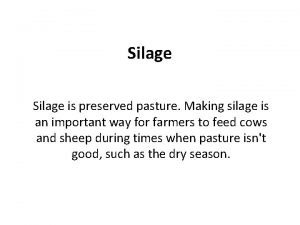Listeriosis Synonyms Circling diseaseSheep Silage Sickness Etiology Listeria





- Slides: 5

Listeriosis Synonyms: Circling disease(Sheep), Silage Sickness. Etiology: Listeria monocytogenes, a small, Gram-positive coccobacillary rods, motile, facultative anaerobes. It lives in the soil and in poorly made silage (PH>5. 5). Host affected: Affects domestics animals especially ruminants, than in human beings, but it can also occur in feral animals, game animals as well as in poultry and other birds. • Encephalitis is the most readily recognized form of listeriosis in ruminants. • Septicemic or visceral listeriosis is most common in monogastric animals, including pigs, dogs, cats, domestic and wild rabbits, and many other small mammals. Transmission: • The natural reservoirs is soil and mammalian GI tracts, both of which contaminate vegetation. • Grazing animals ingest the organism and further contaminate vegetation and soil. • Animal-to-animal transmission occurs via the fecal-oral route. • Listeriosis is primarily a winter-spring disease of feedlot or housed ruminants.

Pathogenesis: Breaks in the oral or nasal mucosa Ingestion M cells in Peyer's patches in the intestine. Migration in cranial nerves Blood stream blood via lymph to various tissues Abortion Septicaemia Encephalitis, often unilateral 1. Lisleria monocytogenes has the ability to invade both phagocytic and non. Pregnant phagocytic cells, to survive and replicate intracellularly and to transfer from cell-to-cell without exposure to humoral defence mechanisms. 2. Internalins, a protein facilitate both the adherence of organisms to host Early infection Late infection membranes and their subsequent uptake. 3. Listeriolysin (cytolytic toxin), which destroys the membranes of phagocytic Abortion Still birth vacuoles allowing listeria to escape into the cytoplasm. 4. In the cytoplasm, the organisms utilize cellular microfiiaments to generate tail-like structures which confer motility. 5. The motile listeria contact the internal surface of the cytoplasmic membrane and induce pseudopod-like projections. These projections containing the bacteria are taken up by adjacent cells. 6. Finally, infecting newly cells.

Clinical Symptoms: 3 forms are recognized: 1. Nervous 2. Septicemic 3. Abortive • The duration of illness is usually longer in cattle than in sheep and goats. • Affected animals shows usually, meningoencephalitis (common in adult ruminants), septicaemia (Common in monogastric and young animals) and abortions. • Dullness, head pressing and unilateral facial paralysis. • Unilateral facial paralysis results in drooling of saliva and drooping of the eyelid and ear. • In advance cases, deviation of head to one side with circling movement of heads, nasal discharge and conjunctivitis, panopthalmitis with pus in anterior chamber of one or boths eyes occurs. • In cattle and sheep: keratoconjunctivitis and iritis (ocular listeriosis), often unilateral and have been attributed to direct contact with contaminated silage. • Abortions are recorded in cattle, sheep and goats but rarely in pigs. • Abortion is not common in sow , however in abortive form of disease, meningoencephalitic signs are not present among these.

Diagnosis: • Characteristic neurological signs or abortion in association with silage feeding. • Isolation and identification of organisms. • Biological methods: inoculation of suspected materials intraperitoneally into Mice revealed focal necrosis of liver and spleen and the organism is isolated from the organs and heart blood. • Histological examination of brain tissue reveals microabscesses and heavy perivascular mononuclear cuffing in the medulla and elsewhere in the brain stem. Treatment: • Chlortetracycline @ 10 mg/Kg, IM for 5 -7 days is the drug of choice for it in cattle butless effective in sheep. • Early stages of septicaemic listeriosis in ruminants respond to systemic therapy with ampicillin or amoxicillin.

• Antibiotic therapy may be poor in neural listeriosis although prolonged high doses of ampicillin or amoxicillin combined with an aminoglycosides may be effective. • Ocular listeriosis requires treatment with antibiotics and corticosteroids injected subconjunctivally. Control: • Poor-quality silage should not be fed to pregnant ruminants. Silage feeding should be discontinued if an outbreak of listeriosis is confirmed. • Feeding methods which minimize direct ocular contact with silage should be implemented. • Vaccination with killed vaccines, which do not induce an effective cell-mediated response, is not protective because L. monocytogenes is an intracellular pathogen. • Feeding of low level of tetracycline @ 10 mg/Kg BW through feeds is recommended. • Live attenuated vaccines prepared with serotype 1 and 4 b @ 2 ml SC at 3 Months of age.

